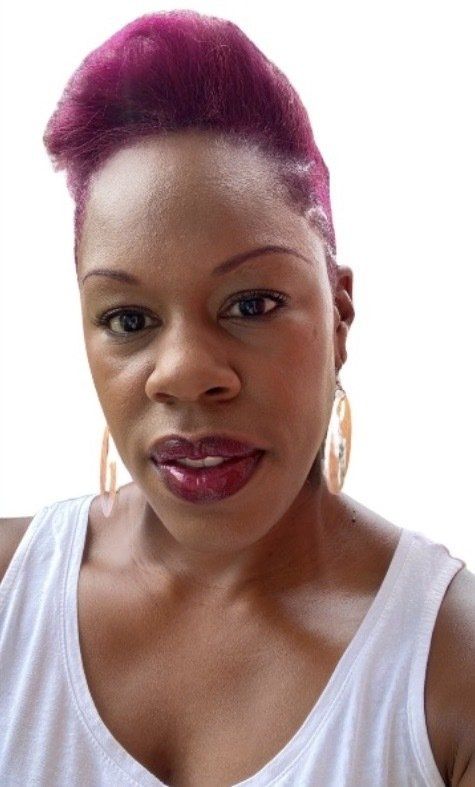TELL YOUR STORY UNAPOLOGETICALLY
ARTIST/SCHOLAR BIO
Dr. Ayo Walker is an Associate Professor of Critical Dance Studies at Columbia College Chicago and a member of the core faculty for Rennie Harris University. As an anti-racist educator utilizing culturally relevant and critical dance pedagogies, her praxis is committed to substantiating the techniques, vernaculars, and genealogies, and embodiment of historically marginalized and othered dance aesthetics in higher education dance spaces. Her general choreographic practice is rooted in visibilizing the “blood memories,” “aesthetic of the cool,” and the “get down” qualities evident in Africanist and Black dance aesthetics. These qualities represent the nature of the practice and how dancers of all backgrounds engaging with the practice and performance of these aesthetics, generates new knowledge contributing to the operational significance for this practice. All of which drives her duty as a complete artist/scholar to reflect the times viscerally and candidly, connecting the past with the present via staged representations of history on a loop. Employing social justice choreography representative of anti-essentialist movement that is at once exposing and undoing stereotypical assumptions historically signifying the Black body politic, her works challenge what performing Blackness is and isn’t.
“Through my research, creative scholarship, and pedagogy I urge the much-needed cultivation of a comprehensive cultural dance literacy beyond the dominant Eurocentric perspective in the United States.” Performed by her dance company Ayo & Company her works have been commissioned by PUSHfest, Sacramento/Black Art of Dance (S/BAD), the Rhythmically Speaking Dance Company and the Modern American Dance Company (MADCO). Ayo & Company premiered and toured their most notable work, “Jadine’s Son” for the 2022 We Create Festival: BIPOC Legacy in the Arts and the BIG MUDDY Dance Festival. This work was then commissioned by the International Association of Blacks in Dance (IABD) 33rd annual Conference and Festival. Ayo’s latest work “P-I-E-C-E-S” premiered and was adjudicated at the 2023 Southeast American College Dance Association Conference (ACDA) 50th Anniversary Festival and subsequently invited to perform at both the GALA and National concerts. Adjudicators Maura Keefe, Daniel Gwirtzman and Juel Lane described the strength of this work as an “unexpected crisscrossing of movement cultures-in conversation with a powerful rhythmic score that keeps revealing new dimensions of movement possibilities.”
As a Performance Studies Practitioner, Choreographer, Dance and African American Studies Educator, she positions her work in the field of Dance and Performance Studies within three specific interdisciplinary and generative frameworks: Research-to-Performance; Practice-Based; and Practice-Led.
Research to Performance: Like Katherine Dunham’s model for, “creating a dynamic confluence between anthropology and dance” as her “seminal methodology—research-to-performance,” Ayo utilizes this ethnographic model as a case study for people in the discipline of dance to reflect and (re)present the doing and undoing of colonialist pedagogies.
Practice-Based: Physical Beats and Caricatureography are both original investigations undertaken in order to gain new knowledge partly by means of practice and the outcomes of that practice. Physical Beats is a phenomenological study of imperceptible mutabilities in dance studies that establishes a new sound dance movement practice via Object-Oriented Ontology. Employing the unconscious collaborative efforts of matter transformation (Oobleck acting as the creative artefact), sound vibrations, and media to investigate the mimetic behavior of dancing objects and human dancers, this movement practice advances the art of choreographic expression and dance making as well as enriches dance spectatorship. Caricatureography establishes a new choreographic structure acting as another pathway for narrative choreography. Caricatureography is the practice and performance of prescencing the corporeal existence of iconic literary characters (acting as the creative artefact) as dancing bodies by relaying their stories through choreography representative of the reader’s experience of them. Her caricatureographies in process include Toni Morrison’s characters the Breedlove's in The Bluest Eye and Jadine and Son, in Tar Baby. What distinguishes her practice from other narrative works is that it moves away from presenting a literal representation of storytelling. Instead, her approach elicits the interpreted experiences of the readers engaging in the character’s stories and then associates movement with the meaning of their interpretations representing anthropomorphic embodied annotations physically exaggerated to inform new ways of making meaning.
Practice-Led: Utilizing culturally relevant and critical dance pedagogies (the nature of the practice), her research is committed to substantiating the techniques, vernaculars, and genealogies of historically marginalized and othered dance aesthetics in higher education dance spaces. In doing so, she has developed an alternative culturally pluralistic pedagogic paradigm—Entercultural Engaged Pedagogy—which explicitly denotes a diversity of cultural views via a guided exploration of dance studies.
Dr. Walker's practice-led research also focuses on decolonizing the body in dance, which is the undoing of domination by ethnocentric ideology to free the body (the nature of the practice) from being dependent on a singular movement practice presenting as the foundation of all dance techniques. Decolonizing the Black (including othered) dancing body acts also as a method of deprogramming monocultural and ethnocentric indoctrination while decoding and de(cypher)ing bodily oppression. Understanding how bodily autonomy vs bodily indoctrination affects dancers embodied cognitive development becomes the essence for freeing the dancer’s groove (the default movement style of the body’s rhythmic interpretation) which affects personalizing their movement identity. Ultimately, freeing your freestyle is about the body’s movement not being located inferiorly or superiorly in the dance discipline’s cultivated hierarchy. This method informs and is informed by her work as both the Hip Hop Pedagogy and Afro-Hip Hop instructor for Rennie Harris University. Harris said in a New York Times article, “what’s special about our curriculum is the pedagogy piece because no one is teaching how to teach Hip Hop, everyone is just teaching people how to do it.”

